Adoption Rates Skyrocket Since the Start of Cat Pawsitive Pro
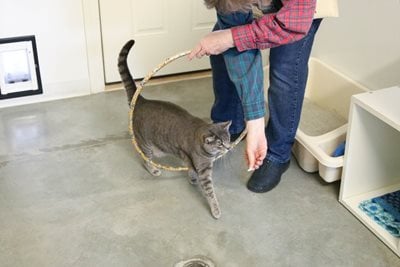
By Yas Nakchbendi of ChirpyCats.com
Cat Pawsitive Pro transforms problem cat behaviors into happy adoptions!
Over the course of the spring semester, the Cat Pawsitive Pro(CPP) program has done wonders for the cats and the staff alike at Simply Cats Adoption Center. Each cat in the CPP program is a success story that far exceeded staff expectations. Shy cats, moody cats, depressed cats or even bored cats with way too much energy never failed to bowl over staff with the transformation in their behaviors that eventually led to their adoptions.
Take Critter, a shy and fearful cat whose owner went into assisted living. Critter was traumatized when he was brought into the shelter by a family member along with his brother Izzy. He was the ideal candidate to be recruited into CPP and his personality just blossomed from there.
Staff began training him by just capturing a “slow blink” to coax him out of his cubby. From there he progressed to “come” and eventually he gained enough confidence and trust in his trainers, venturing out of hiding from his safety bubble. This bravery literally set jaws dropping! Staff and volunteers could not believe his new-found confidence and refer to him as one of their most improved CPP cats. After his enrollment in the program, Critter would actively seek affection by rolling over for human interaction and continues to woo his new owners in his forever home!
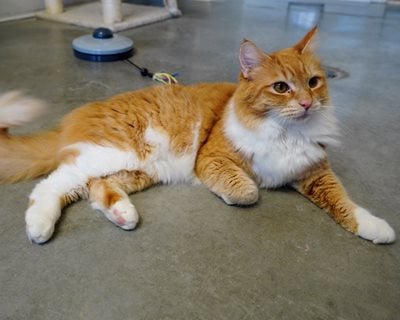
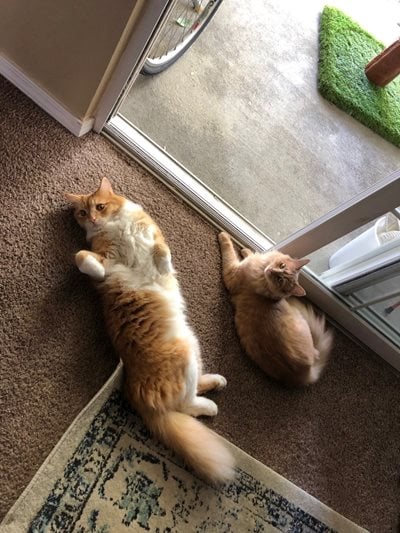
Then there was moody Roxanne, their long-term resident, 243 days to be exact, that they thought was never going to be adopted. She clearly hated shelter life, but CPP training calmed her and she was soon snapped up for adoption!
“Roxanne was adopted after her family saw her featured in a local news article that highlighted the CPP program here at Simply Cats. The article primarily focused on Roxanne, since she was our longest-staying resident at the time. They came in shortly after seeing the article and took her home! She is doing very well in her new home and is quite happy to have a family of her own!” says Cat Pawsitive Pro Team Leader Emily Patterson.
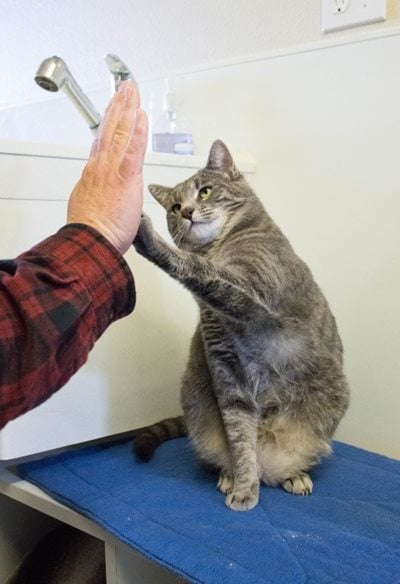
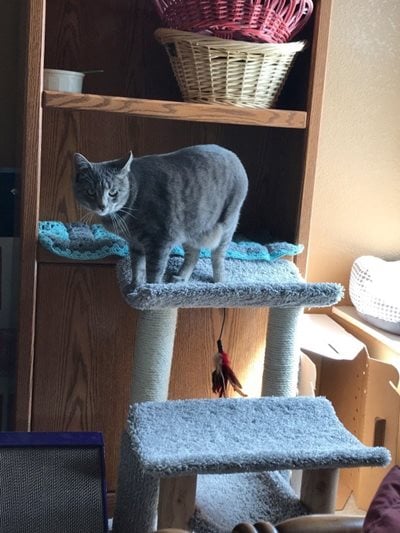
Executive Director Patty Cutler could not be happier with the increased adoption rates at the shelter.
“This program has done amazing things for the shy cats at our shelter. It has given them enough confidence to come out of their shell and respond positively to the trainers and visitors. It has given the high energy cats an outlet so that their overall behavior is calmer and more acceptable. I have been very pleased with the number of participating cats that have found homes more quickly than anticipated! It has been a huge success at our shelter,” she says.
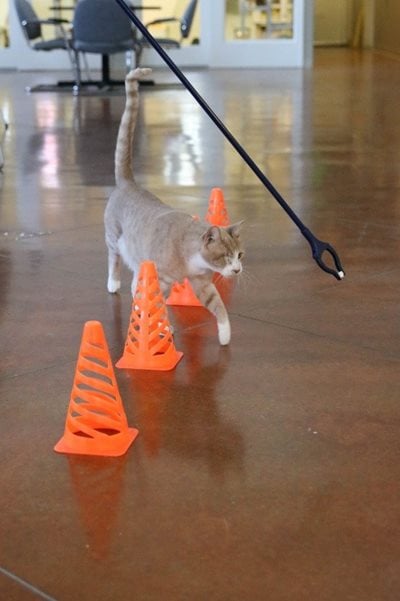
After seeing the changes in the cats, Team Leader Deb McDougall is excited at the positive impact CPP will have on all shelter cats in their care.
“This program is remarkable. Observing the changes in negative or survival behaviors to positive
behaviors was so surprising. Watching fearful cats become trusting and bored cats become more
engaged was rewarding. And, our naturally outgoing cats had a chance to show off just how smart they were. Of course, when the CPP cats found homes, we knew it was due, in part, to the magic of the CPP program,” she says.
Staff and volunteers agree that clicker training isn’t just about teaching the cats tricks, but a powerful communication tool, which is a great benefit to both shelter staff and cats. Enrichment volunteer Leslie Zobel had her breakthrough moment with a cat called Paisely that insisted on claws when doing high fives. By shifting her focus and method to ‘capturing’ and rewarding a calm demeanor, she was able to trigger the desired response from Paisely. He finally understood what she was asking of him and he delivered it!
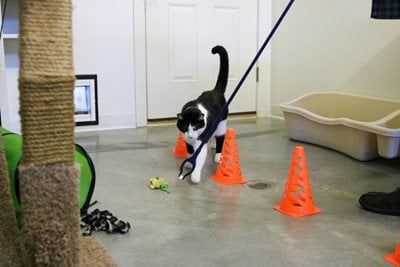
“Clicker training is, among other things, a means to an end, the end being a collaboration between a cat and a person (trainer or adopter), where each understands what the other wants and is capable of giving. And this is way more powerful than tricks, this is communication,” says Leslie.
But it was obvious to everyone that the greatest benefit to the cats was how quickly they were getting adopted!
“All of the cats in the program were on the verge of not having anyone want to adopt them for one reason or another. After starting the program, we had to add more cats into the CPP program, because they kept getting adopted almost as fast as we could train them!” says enrichment volunteer Zeke Giesecke.
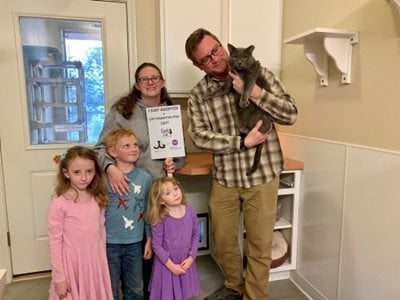
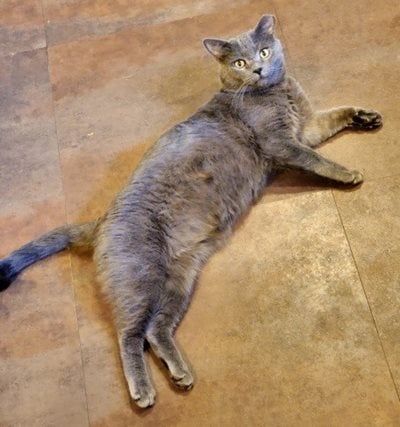



It’s not just the cats that benefit. The staff and volunteers gained a deeper understanding of communicating with cats and their behavior through the CPP program.
“There are so many benefits that Cat Pawsitive Pro has to offer. Because there was a bigger focus on cats that are struggling, whether it’s aggression or shyness, we were able to work more closely in a purposeful way with those cats to help them thrive in the shelter environment. Some cats have way too much energy, and clicker training gives them an outlet. Other cats are too scared to come out of hiding, and clicker training helps them build their confidence and become more trusting of people. Regardless of the challenge the cat is struggling with, Cat Pawsitive Pro gives them a chance to be the best version of themselves,” explains Emily.

“CPP training provided a morale booster whether it was through the increased human interaction, a love of Halo chicken, or a combination of the two. In my view, seeing so many of these CPP cats find a home is the greatest success of the program,” says enrichment volunteer Jerome Berner.
Team Leader Paige Szathmary agrees. “Cats like Roxanne and Charlotte had so much less of a chance before the training began,” she says.
Some of the tricks taught during the CPP semester were sit, high five, nose bump, hoop jump, weave through cones, eye contact, slow blink, get in the carrier, and jump over a bar.
What’s inspiring to know is that some of these adopted cats still have many tricks up their paws in their forever homes! “Roxanne and Charlotte are still doing high fives in their homes!” says Paige.
YOU can improve the lives of cats at risk. Donate today to The Jackson Galaxy Project’s Cat Pawsitive Program and transform the places and people that support at-risk pets!


